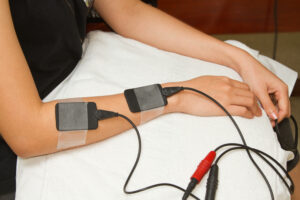Electrical Stimulation and Post-Stroke Recovery
Electric stimulation (e-stim) has long been used to stimulate muscles and activate nerves in recovering stroke patients. It also reduces swelling and is frequently used on foot drops, shoulder subluxation, elbow extension, and wrist and finger extension, which many stroke survivors often find challenging.
It is a therapeutic treatment performed by a physical therapist or occupational therapist. They use an electronic stimulation device with three components that have different functions: the electrode pads, a device that releases electric impulses, and the control.
E-stim has a wide range of benefits for stroke survivors. It can prevent muscle atrophy, improve motor skills, and help patients overcome other physical effects of a stroke.
However, there are limitations on who can be treated using e-stim. The following should never consider e-stim as part of their therapy:
- People with electrical implants or devices in the body, such as pacemakers;
- People who experience decreased sensation or numbness in their extremities should use it with extreme caution and ask their physicians if they could undergo e-stim. The procedure should only be performed by a health professional;
- People with open wounds or malignant tissues;
- Pregnant women;
- People who are diagnosed as epileptic.
It’s always best to consult your physician and physical therapist before undergoing any type of therapy, especially if it is electronic stimulation.
How Electrical Stimulation Works
E-stim uses electrical impulses to stimulate the muscles and nerves to move or contract. The electrode pads are placed in the area that needs stimulation, and once the muscles contract or react to the electrical impulses, the body sends information to the brain that activates the related damaged areas.
The brain’s neuroplasticity allows the cortex to create new connections due to these signals from the muscles and helps stroke survivors regain some sensation and movement.
When a person survives a stroke, the brain suffers damage that limits sensation and neural networks that connect the muscles to the brain. The electrical signals in e-stim therapy jumpstart the body’s muscles and send alerts that trigger the brain to reconstruct the connections needed to move the affected muscles or limbs.
The brain’s neuroplasticity allows the healthy parts to take over the functions of the damaged areas. These new neural pathways formed during e-stim therapy can further boost neuroplasticity and speed up a stroke survivor’s recovery, especially limb function.
Types of Electronic Stimulation
Not all patients receive the same type of e-stim therapy; it all depends on the severity of the patient’s condition and the muscles that would require stimulation.
These are the types of e-stim therapies often given to post-stroke patients.
Functional Electrical Stimulation (FES)
This is the most common type of e-stim therapy for stroke survivors. It helps patients regain the use of their muscles, especially improving the strength in their hands and their ability to grasp objects.
Neuromuscular Electrical Stimulation (NMES)
This e-stim therapy is used to strengthen muscles and recover motor skills in weakened limbs.
Transcutaneous Electrical Neuromuscular Stimulation (TENS)
TENS is often used to treat post-stroke pain. It does not send electrical impulses into the muscles but instead sends them to the skin’s surface. This prevents pain signals from reaching the brain and allows post-stroke survivors to focus on recovery and lessen the pain associated with motor therapy.
Interferential Current
This treatment is often used on patients with spasticity issues. Electrodes create a higher intensity of electrical impulses to treat various symptoms in stroke survivors. It increases the chances of making a full recovery for arm and limb movements.
Electronic Stimulation and Recovering Arm Movement

There is growing evidence that e-stim is a viable option for treating upper arm and limb movement recovery after a stroke. E-stim can be used to stimulate muscle contraction in weakened or paralyzed limbs to improve mobility and enhance therapy.
This therapy has been used since the 1960s and has been explored as a therapeutic treatment in other conditions that affect the movement of the upper limbs.
Electronic stimulation helps strengthen weak muscles, increases range of motion, improves motor control, and reduces spasticity and shoulder subluxation. It also limits the pain associated with subluxation or the partial dislocation of the shoulder joint and enhances sensory awareness in the affected areas.
E-stim engages post-stroke patients and gives sensory and visual feedback that promotes motor relearning. E-stim can also reverse the effects of muscle disuse atrophy and bring about positive muscle fiber changes during treatment.
The Benefits of Electrical Stimulation for Stroke Patients
E-stim has the following benefits for post-stroke patients who want to increase mobility in their upper limbs and arms.
Introduces Muscle Movement into Paralyzed Muscles
This treatment can instigate muscle movement in paralyzed muscles through electrical stimulation. The electrical impulse will cause muscles to contract and rewire the brain to activate the paralyzed muscles.
Improves Shoulder Subluxation
Post-stroke survivors often experience subluxation in the shoulders or a mild dislocation. Despite the benign condition, it can be incredibly painful, and using e-stim could reduce pain and improve mobility of the limbs and arms.
Lessen Edema
Edema is the build-up of excess fluid in the body. Hand edema is a common symptom experienced by stroke survivors due to increased venous congestion in the limbs. This occurs when muscles are inactive and cannot move the fluid through the body’s lymphatic system. This fluid collects in certain areas and restricts muscles and ligaments, causing pain and stiffness.
The introduction of electronic stimulation in the affected areas can significantly lessen the incidence of edema since the muscle contractions induce fluid movement throughout the body.
Electric Stimulation Improves Mobility in the Arms
A stroke can be seen as a death sentence, but it should not be. Stroke survivors can still regain motor skills they have lost because the brain can adjust and form new connections, including motor and functional movements of the limbs and arms.
Full recovery is only possible with the right treatments. Stroke survivors should consider emerging technologies and therapies that can help them on their way to a quick recovery and a return to the life they used to know.
Watch Tara Tobias give her personal opinions regarding electrical stimulation



